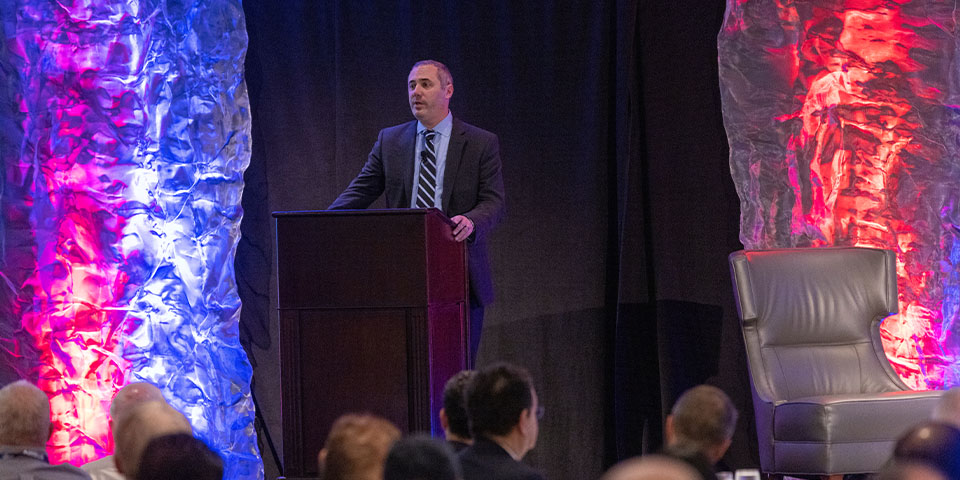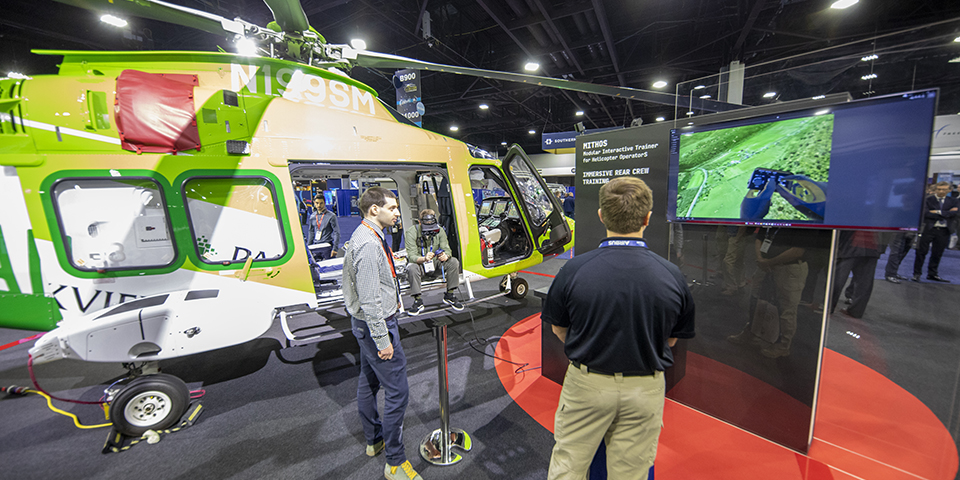We’re proud of the important contribution that Leonardo helicopters make in support of HEMS operators worldwide, providing lifesaving care when it is needed most. It was fitting therefore that EMS was the focal point of our breakfast event at this year’s Heli-Expo in Atlanta.
We were delighted to welcome a panel of leaders from the EMS sector, representing operators from different geographies, all of whom have in-depth experience of the unique demands of HEMS missions.
Expert insights on HEMS
Our round-table guests included Capt. Arnaud Francois Marcel Martinez, CEO of The Helicopter Company (THC) in Saudi Arabia; Mike Weimer, COO of Life Flight Network, the largest not-for-profit air medical transport service in the United States; Mike Stanberry, President and CEO of Metro Aviation, which provides air medical transport services across the US; and Chris Bradshaw, President and CEO of Bristow Group, which has extensive global operations covering SAR/EMS missions.
The panel discussed some of the key challenges and emerging themes in HEMS operations, including the continued role that the AW139 plays in Middle Eastern HEMS operations, the improvements and collaboration between the US operators and Customer Support, Services & Training, the anticipation of the AW09 into the US HEMS market, and the attributes of the AW139 that support SAR missions globally.

Meeting the EMS challenge
During the breakfast event, we highlighted how the Leonardo Helicopters product range is capable of fulfilling all market requirements for EMS operations worldwide. Globally, there are more than 650 of our helicopters performing search and rescue and EMS missions in over 50 countries. Meanwhile, in the North American EMS market, our fleet numbers more than 100 helicopters spanning the AW119, AW109, AW169 and AW139.
Leonardo Helicopters Managing Director Gian Piero Cutillo underlined our commitment to continue to deliver the most capable and high-performing helicopters to support lifesaving missions anytime, anywhere. And he outlined how both the AW139 and AW169 have demonstrated their value both in the US and worldwide thanks to the versatility and ergonomics of the cabin, alongside class-leading performance.
He discussed the achievement of the AW139 during the early months of the Covid-19 pandemic when it became the first civil certified helicopter capable of transporting bio-containment equipment, rapidly setting a standard – in coordination with aviation and healthcare authorities.
Meanwhile, the AW169 also boasts unique attributes, such as its APU-mode – the only helicopter in its weight category with this feature. It enables the crew to use key systems for medical stabilisation with the added safety of the rotors being stopped.
Sam Schaab, Leonardo Helicopters’ HEMS Specialist, underlined the characteristics that are common across the product range – including exceptional cabin capability, where the patient is the central focus. This means that all our helicopters enable full patient access with all medical equipment within easy reach.
He also spoke of cabin modularity as a key feature of our product range, alongside the flexibility to take advantage of new developments in a rapidly changing medical landscape. We will continue to advance technologies in both the cabin and the cockpit to provide the best possible levels of capability, he said.

AW09 and AW609 to broaden EMS capabilities
We are strengthening our EMS capabilities further with the addition to the product line of the new generation single-engine AW09, which was also a major feature of our presence at Heli-Expo. The AW09 is ideally suited to EMS operations and is the only platform in its category with clamshell doors and a full access cabin.
Time is a priceless commodity for EMS missions, which is why the AW609 – the world’s first civil-certified tiltrotor – has huge potential to support future EMS operations because of its transformational capabilities. Flying at almost twice the speed of a conventional helicopter, the AW609 doubles the reach in the critical ‘golden hour’ where prompt medical intervention is so vital. Its long range also enables direct patient or organ transfer between hospitals.
Investment in training and digitalisation
Beyond the product line itself, we have also been investing in capability – particularly in developing tailored training for EMS operations, supporting pilots and maintainers but also aimed at rear medical crew.
Two examples are the HERos Bay (Helicopter Rescue Operations Simulators) courses at our facility in Sesto Calende and the introduction of MITHOS – the Modular Interactive Trainer for Helicopter Operators simulator, which was on display in Atlanta during Heli-Expo.
We recognise that digitalisation will play an increasingly pivotal role in future training and support by helping operators to reduce costs by travelling less and performing activities at their own bases. Innovations such as our VxR (Virtual and Extended Reality) simulator and enabling in-flight data transfer in support of telemedicine demonstrate our determination to stay at the forefront of technological trends.


